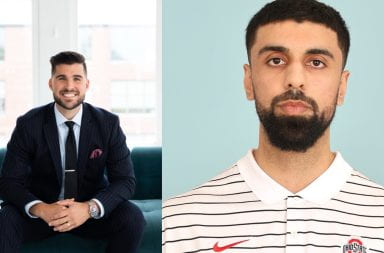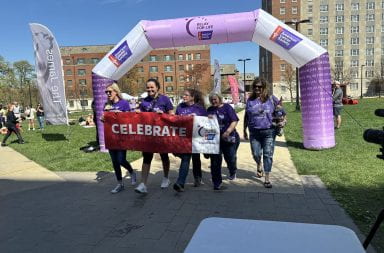The Ohio State Second-year Transformational Experience Program has begun, but that doesn’t mean everyone on campus is thrilled about it.
While some participants and leaders of STEP are enthusiastic about the year ahead, others have expressed concerns about some elements of the potentially temporary program.
Students participating in the Student Life program will be given a $2,000 stipend, placed in large group clusters and smaller group cohorts and paired with a faculty mentor.
Each cluster will have a ratio of 100 students to five or six faculty members and each cohort will have about 20 students per faculty member, Javaune Adams-Gaston, vice president for Student Life, said in an interview with The Lantern.
“It’s $2,000 for an experience and that is guided by the faculty. So the faculty will work with students around the experiences,” she said.
Some students, however, are apprehensive about STEP.
“I was going to participate (in the STEP pilot) but I ended up not signing up,” Brennan Hall, second-year in political science, said. “I was kind of confused as to what exactly the program was and I didn’t know how much time I would have to put into it.”
Brittany Kahn, a second-year in public affairs participating in STEP, said while living on campus was a good fit for her, she can understand why it’s not for everyone.
“I’m very comfortable here,” she said. “I think it was the right move for me. I think some people don’t exactly like the campus life and I understand why a lot of people choose to not live on campus.”
The OSU Board of Trustees approved the program pilot, which will cost the university more than $2 million in cash reserves, in an April 2012 meeting.
The university hopes to have programs and housing to accommodate every second-year student by 2016, a point that was discussed at the August 2012 Board meeting where a $396 million North Campus renovation plan was approved.
Though second-year students will eventually be required to live in residence halls, they will not be required to participate in STEP, Adams-Gaston said.
“The point of (students living in residence halls) is to have an experience and STEP is that experience at this point, we’ll know better as we go along if that is the only experience,” she said.
David Stetson, faculty director of STEP, echoed similar ideas for the future of STEP.
“I can’t imagine that we would ever require a student to do STEP. What we hope is that we can build a program that every student wants to participate in,” he said.
One thousand second-year students and 54 faculty members are participating in the pilot of STEP.
Originally 2,000 students were to participate in the pilot, but the scope was eventually narrowed, Adams-Gaston said. She did not provide more information as to why.
About 1,400 first-year students applied for the program last spring and 1,000 were randomly selected, she said.
Faculty members were nominated by members of the faculty committee, self-nominated or nominated by students, Stetson said. They come from disciplines across campus and range in age and experience level.
Faculty will be given a $5,000 discretionary fund for their participation, he said, and can use this money in any way they see fit. The money for the faculty’s compensation will come from the same cash reserves as the student’s stipend.
“The faculty can use this money at one extreme to support themselves and at another extreme to pay for the program that they’re giving the students,” Stetson said.
Adams-Gaston said STEP is meant to be similar to the First Year Success Series offered to freshman students with added emphasis on connection with faculty.
Students can spend their stipends on any combination of six experiences: study abroad, service learning, research, leadership, internships and creative arts endeavors, Stetson said.
“We’re asking the students to develop a project that will further their progress toward their future, however they want to define that,” he said.
Kahn said she wants to use her stipend for study abroad or research.
“My initial thought was study abroad and I would love to do that. I was asking around and that seems to be everyone’s answer,” Kahn said.
The program is broken up between fall and spring semesters.
Fall Semester will serve as an introduction to STEP and what OSU has to offer students with mostly large group sessions, Stetson said.
Alison Crocetta, associate professor of art and a participating faculty member, said her cohort will use Fall Semester to hone in on student’s strengths through workshops where students will “identify their strengths as a tool for focusing their research project.”
In addition to large group meetings, students will have to complete a co-curricular component.
The co-curricular components are broken into four sessions. One will be financial literacy, and students can choose between global citizenship, career exploration and preparation, academic success, information literacy and health and wellness for their remaining three, Adams-Gaston said.
“The fall is really getting the group ready to begin approaching a more focused level of problem-solving and imagining of their research project,” Crocetta said.
All students and faculty participating in STEP met for the first time on Monday. After coming together as an entire group they broke into their 100-student houses and then 20-student cohorts.
Kahn, who is also president of Baker Hall East hall council, said she was excited to meet her faculty mentor.
“This is the first time I met her,” she said. “I think she’s great. She’s very funny and smart and very excited about the program.”
Others, though, are leery of faculty and students interacting in residence halls.
Tim Valentine, Arts Scholars program manager, said in a September interview with The Lantern that students’ initial fear stems from “thinking there is a chance that you walk out in your bathrobe and there is your physics professor.”
To calm these fears, new residence halls will have more spaces conducive to faculty-student interaction, Adams-Gaston said.
“They (faculty) wont be in (students’) rooms at all. They’ll be in public places and as we develop more spaces in the university, we are keeping those spaces in mind,” she said.
Interaction with other students and faculty in residence halls helps students’ “sense of belonging to the community,” Adams-Gaston said. She added that she hopes this will aid OSU’s graduation and retention rate in addition to providing students with a more quality college experience.
Crocetta felt similarly.
“It’s really an unprecedented union between the academic side of things and the student’s personal development. It’s a great opportunity to focus on the student’s complete experience here at OSU,” Crocetta said.
In the spring, students will narrow their focus and come up with a plan to spend their stipend with the help of their faculty mentor.
Students will complete a contract stating how they plan to spend the money and will have until August 2015 to complete whatever project they come up with, Adams-Gaston said.
Contracts can be individual or completed by students in groups, she added.
As OSU moves toward the 2016 goal to have all second-year students live in residence halls, programs like STEP will help students welcome this, Adams-Gaston said.
“The goal is that students will see the value in terms of their experience and in terms of their success.”
This article has been revised to reflect the following correction:
Correction: Aug. 22, 2013
An earlier version of this story stated STEP student participants would have to complete a co-circular component. In fact, they will complete a co-curricular component.


